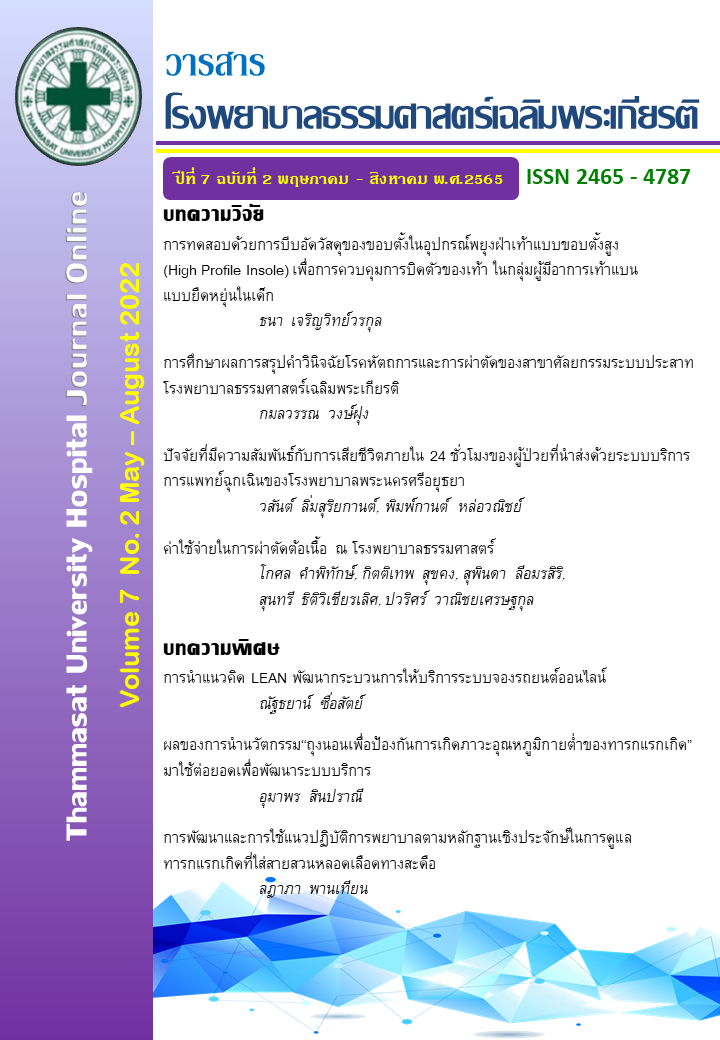การทดสอบด้วยการบีบอัดวัสดุของขอบตั้งในอุปกรณ์พยุงฝ่าเท้าแบบขอบตั้งสูง (High Profile Insole) เพื่อการควบคุมการบิดตัวของเท้า ในกลุ่มผู้มีอาการเท้าแบนแบบยืดหยุ่นในเด็ก
คำสำคัญ:
เท้าแบนแบบนิ่ม, เท้าแบนแบบยืดหยุ่น, แผ่นรองในรองเท้า, อุปกรณ์พยุงฝ่าเท้าบทคัดย่อ
ความสำคัญของปัญหา: การรักษาเท้าแบนในเด็กโดยการใช้อุปกรณ์เสริม UCBL (University of California Biomechanics Laboratory) เป็นวิธีการรักษาหนึ่งที่ได้ผลดีที่สุด แต่เนื่องจากอุปกรณ์ดังกล่าวมีลักษณะแข็งและมีขอบสูงรอบด้าน ทำให้อาจเกิดรอยกดจนถึงมีอาการเจ็บที่เท้าของผู้ใช้งานได้ จึงมีอัตราการใช้ที่ค่อนข้างต่ำ การรักษาอีกวิธีหนึ่งคือการใช้แผ่นรองในรองเท้า คู่กับรองเท้าที่มีโครงแข็งบริเวณรอบส้นรองเท้า ซึ่งวิธีนี้มีอัตราการใช้อุปกรณ์ที่มากกว่า แต่การหารองเท้าที่มีโครงแข็ง และถูกต้องตามเครื่องแบบนักเรียนนั้นหาได้ยาก และมักมีราคาสูง ทางผู้วิจัยจึงได้ทำการออกแบบอุปกรณ์ใหม่ซึ่งเป็นการรวมจุดเด่นของอุปกรณ์เสริม UCBL และ TCI เข้าด้วยกันเป็นอุปกรณ์ที่เรียกว่า “อุปกรณ์พยุงฝ่าเท้าแบบขอบตั้งสูง” โดยคาดหวังว่าอุปกรณ์นี้สามารถเพิ่มอัตราการใช้และลดผลแทรกซ้อนจากการใช้อุปกรณ์ได้ การทดสอบในงานวิจัยนี้จัดทำขึ้นเพื่อทดสอบความแข็งแรงของวัสดุที่ถูกเลือกมาใช้ในการผลิตอุปกรณ์พยุงฝ่าเท้าแบบขอบตั้งสูง
วัตถุประสงค์: เพื่อทดสอบความแข็งแรงของวัสดุที่ถูกเลือกมาใช้ในการผลิตขอบตั้งสูงของ “อุปกรณ์พยุงฝ่าเท้าแบบขอบตั้งสูง” โดยการวัดความสามารถในการรักษาสภาพต่อแรงที่กระทำต่อขอบตั้งของอุปกรณ์
วิธีดำเนินการวิจัย: ขอบตั้งสูงของ“อุปกรณ์พยุงฝ่าเท้าแบบขอบตั้งสูง”ถูกผลิตขึ้นจากวัสดุสองชนิดประกบกันคือ Podiaflex® 1.2 mm และ Flexan® series1 0.53mm โดยแรงที่ใช้ในการทดสอบความแข็งแรงของขอบอุปกรณ์เกิดจากการควบคุมแรงดันลมในกระบอกสูบเพื่อสร้างแรงผลักที่ปลายกระบอก เพื่อใช้ในการทดสอบความเปลี่ยนแปลงเปรียบเทียบกันระหว่างรองเท้า และ รองเท้ากับอุปกรณ์พยุงฝ่าเท้าแบบขอบตั้งสูง
ผลการศึกษา: ผลการทดสอบแสดงให้เห็นชัดเจนถึงการลดลงของความผิดรูปของรองเท้าและอุปกรณ์พยุงฝ่าเท้าแบบของตั้งสูง เปรียบเทียบกับรองเท้าเพียงอย่างเดียว โดยจากผลการทดสอบรองเท้าและอุปกรณ์สามารถลดปริมาณความผิดรูปจากแรงที่กระทำในระดับเดียวกันกับรองเท้าอย่างเดียวได้ถึงสองเท่า สรุปผลได้ว่าเป็นผลจากโครงสร้างของอุปกรณ์พยุงฝ่าเท้าแบบขอบตั้งสูงที่เสริมความแข็งแรงให้กับรองเท้าที่ใช้ในการทดสอบ
สรุป: โครงแข็งบริเวณรอบส้นรองเท้าและขอบตั้งสูงของ“อุปกรณ์พยุงฝ่าเท้าแบบขอบตั้งสูง” ให้ความสามารถในการควบคุมการบิดตัวของเท้าในแบบเดียวกัน งานวิจัยนี้ใช้ในการทดสอบวัสดุที่ถูกเลือกมาใช้ในการผลิตขอบตั้งสูงของอุปกรณ์ ซึ่งผลการทดสอบแสดงให้เห็นว่าขอบของอุปกรณ์ที่ติดตั้งในรองเท้าสามารถเสริมความแข็งแรงของโครงสร้างรองเท้าเพื่อต้านทานต่อแรงที่อาจเกิดขึ้นต่อขอบด้านในของรองเท้าและอุปกรณ์ได้เป็นอย่างดี
เอกสารอ้างอิง
Whitman R. The classic: a study of the weak foot, with reference to its causes, its diagnosis, and its cure; with an analysis of a thousand cases of so-called flat-foot 1869. Clin Orthop Relat Res 2010; 468(4): 925–939. doi: 10.1007/s11999-009-1130-1.
Halabchi F., Mazaher, R., Mirshahi M., & Abbasian L. Pediatric Flexible Flatfoot; Clinical Aspects Algorithmic Approach. Iran J Pediatr 2013; 23(3):247–260.
Panjavi B., & Mortazavi S. Rotational deformities of the lower limbs in children. Iran J Pediatr. 2007; 17(4): 393–397.
Stolzman S., Irby M.B., Callahan A. B., & Skelton J.A. Pes planus and paediatric obesity: a systematic review of the literature. Clin Obes. 2015; 5(2):52–59. doi: 10.1111/cob.12091
Kim H.Y., Shin H.S., Ko J.H., Cha Y.H., Ahn J.H., & Hwang J.Y. Gait analysis of symptomatic flatfoot in children: An observational study. Clin Orthop Surg. 2017; 9(3):363–373. doi: 10.4055/cios.2017.9.3.363
Carlson J., & Berglund G. An effective orthotic design for controlling the unstable subtalar joint. orthotics and prosthetics. 1979; 33(1):39-49.
Payehdar S., Saeedi H., Ahmadi A., Kamali M., Mohammadi M., & Abdollah V. Comparing the immediate effects of UCBL and modified foot orthoses on postural sway in people with flexible flatfoot. Prosthet Orthot Int 2016; 40(1):117–122. doi: 10.1177/03093
Dacharux W.M., & Chadchavalpanichaya N. The Use of UCBL Orthosis in Patients with Flatfoot in Foot Clinic, Siriraj Hospital. J Med Assoc Thai. 2017; 100(7):800–807.
Jane MacKenzie, A., Rome, K., & Evans, A. M. The efficacy of nonsurgical interventions for pediatric flexible flat foot: A critical review. J Pediatr Orthop. 2012; 32(8): 830–834. doi: 10.1097/BPO.0b013e3182648c95.
Hurst B., Branthwaite H., Greenhalgh A., & Chockalingam N. Medical-grade footwear: the impact of fit and comfort. J Foot Ankle Res. 2017; 10(1):2. doi: 10.1186/s13047-016-0184-z
Zamosky I. Shoe Modifications in Lower-Extremity Orthotics. Bulletin of Prosthetics Research. Bull. Prosthet. Res. 1964; 9: 54–95.
Wenger D.R., Mauldin D., Speck G., Morgan D., & Lieber R.L. Corrective shoes and inserts as treatment for flexible flatfoot in infants and children. J Bone Joint Surg Am. 1989; 71(6):800–810.
Gijon-Nogueron G., Palomo-Toucedo I., Gil-Tinoco,A., Ortega-Avila A.B., & Munuera-Martínez P.V. Effect produced on ground reaction forces by a prefabricated, weight-bearing and non-weight-bearing foot orthosis in the treatment of pronated foot: Pilot study. Medicine (Baltimore). 2018; 97(22): e10960. doi: 10.1097/MD.0000000000010960.
Gijon-Nogueron G., Cortes-Jeronimo E., Cervera-Marin J. A., García-de-la-Peña R., Benhamu-Benhamu S., & Luque-Suarez, A. Foot orthoses custom-made by vacuum forming on the non-load-bearing foot: Preliminary results in male children with calcaneal apophysitis (Sever’s disease). Prosthet Orthot Int. 2013; 37(6):495-8. doi:10.1177/0309364613482844
Albert S., & Rinoie C. Effect of custom orthotics on plantar pressure distribution in the pronated diabetic foot. J Foot Ankle Surg. 1994; 33(6):598-604.
Lo W.T., Yick K.L., Ng S.P., & Yip J. New methods for evaluating physical and thermal comfort properties of orthotic materials used in insoles for patients with diabetes. J Rehabil Res Dev. 2014; 51(2):311–324. doi: 10.1682/JRRD.2013.01.0012.
Pastina M., Mihai A., and Bilalis N. Finite element analysis for insole-sole prototypes, In: 4th ICAMS. 2012; 2–7.
Liu H., Wu Z. & Lam W.K. Collar height and heel counter-stiffness for ankle stability and athletic performance in basketball. Res Sports Med. 2017; 25(2):209–218. doi: 10.1080/15438627.2017.1282352.
Adam A.T., "Pascal's principle - Definition, Example, & Facts”.; [internet]. 2015 [cited 2021 Apr 10]. Available from: https://www.brita
nnica.com/science/Pascals-principle
Aboutorabi A., Saeedi H., Kamali M., Farahmand B., Eshraghi A., & Dolagh R.S. Immediate effect of orthopedic shoe and functional foot orthosis on center of pressure displacement and gait parameters in juvenile flexible flat foot. Prosthet Orthot Int. 2014; (38)3:218-23. doi: 10.1177/0309364613496111
Séamus Kennedy, BEng (Mech), Material choice in foot orthotic design [internet]. 2008 [cited 2021 Apr 10]. Available from: http://www.hersco.com/education/MaterialChoices.pdf
Ravindra S. Goonetilleke, The Science of footwear. New York: CRC Press; 2012: 442.
Bruce E. Williams, DPM, The American Academy of Podiatric Sports Medicine’s assessment test A three-point approach to testing running shoes [internet]. 2010 [cited 2021 Apr 10]. Available from: https://lermagazine.com/article/a-three-point-approach-to-testing-running-shoes
Stephen Urry, Queensland university of technology: School shoe test report.; [internet]. 2011 [cited 2021 Apr 10]. Available from: http://shoereview.com.au/schoolshoereview.html
Cavanagh P.R., Rodgers M.M., & Iiboshi A. Pressure distribution under symptom-free during barefoot standing, Foot Ankle. 1987; 7(5): 262-76. doi: 10.1177/107110078700700502.
Maia Grdzelidze. A Statistical Evaluation and Analysis of The Results of Shoes Wear Test Method for A Pilot Study [internet]. 2017 [cited 2021 Apr 10]. Available from: https://www.researchgate.net/profile/Maia-Grdzelidze/publication/325359275_A_STATISTICAL_EVALUATION_AND_ANALYSIS_OF_THE_RESULTS_OF_SHOES_WEAR_TEST_METHOD_FOR_A_PILOT_STUDY/links/5b0c0d210f7e9b1ed7fa9f09/A-STATISTICAL-EVALUATION-AND-ANALYSIS-OF-THE-RESULTS-OF-SHOES-WEAR-TEST-METHOD-FOR-A-PILOT-STUDY.pdf
Bok S.K., Kim B.O., Lim J.H., & Ahn S.Y. Effects of Custom-Made Rigid Foot Orthosis on Pes Planus in Children Over 6 Years Old. Ann Rehabil Med. 2014;38(3): 369-375. doi: 10.5535/arm.2014.38.3.369
ดาวน์โหลด
เผยแพร่แล้ว
รูปแบบการอ้างอิง
ฉบับ
ประเภทบทความ
สัญญาอนุญาต
ลิขสิทธิ์ (c) 2022 วารสารโรงพยาบาลธรรมศาสตร์เฉลิมพระเกียรติ

อนุญาตภายใต้เงื่อนไข Creative Commons Attribution-NonCommercial-NoDerivatives 4.0 International License.



